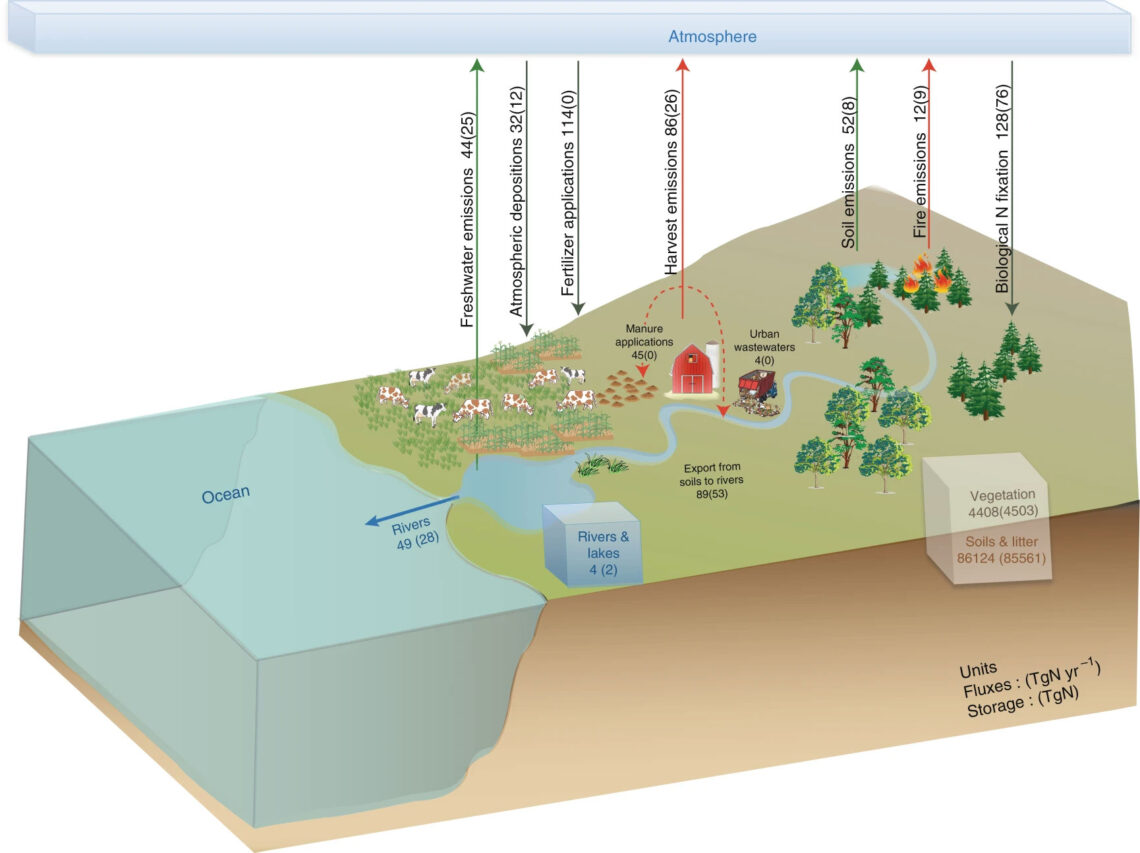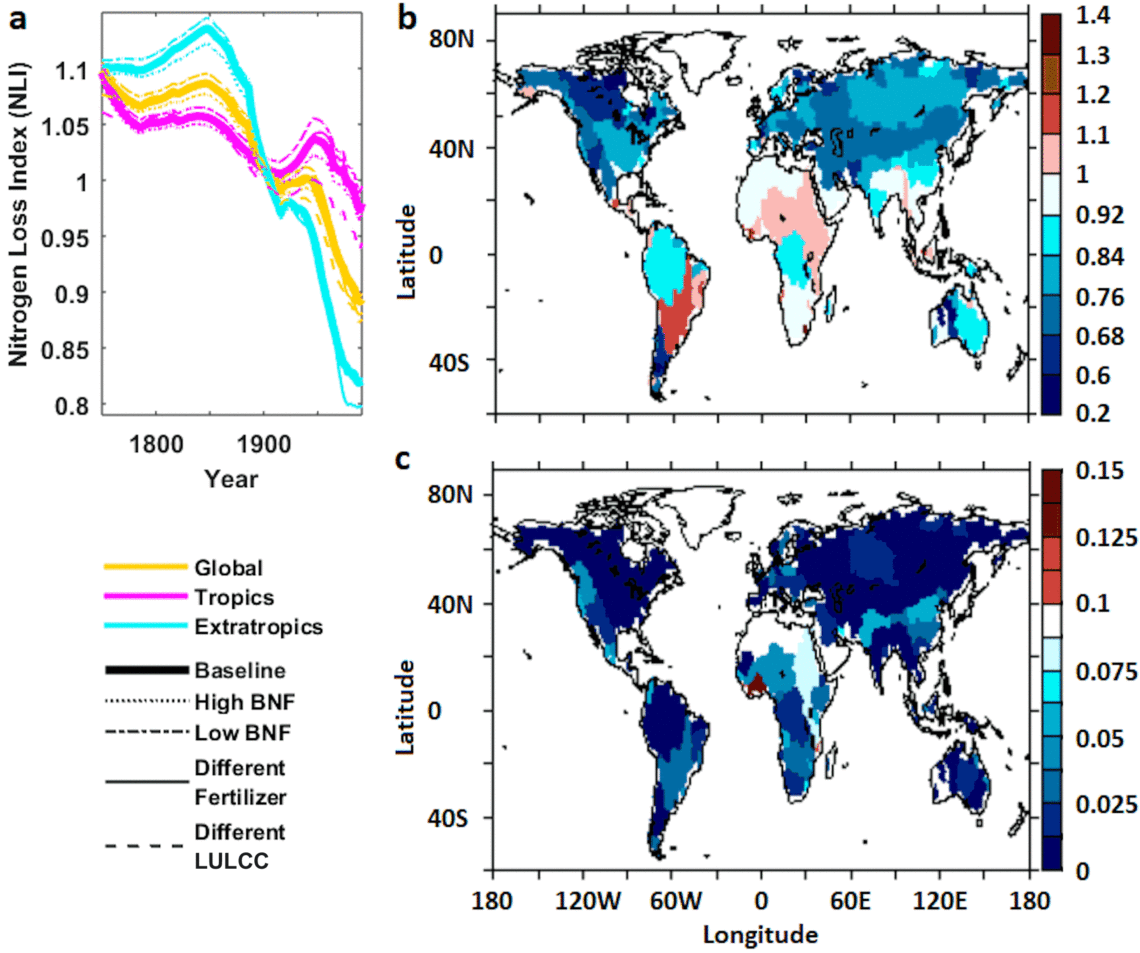April 26th, 2019
Key Findings
- Globally, land currently sequesters about 11% of annual reactive nitrogen inputs.
- Some river basins, however, sequester >50% of their reactive nitrogen inputs, buffering coastal waters against eutrophication and society against greenhouse gas-induced warming.
- Other basins release >25% more than they receive. These basins are mostly located in the tropics, where recent deforestation, agricultural intensification, and/or exports of land nitrogen storage can create large pollution sources.
- The tropics produce 56±6% of global land nitrogen pollution despite covering only 34% of global land area and receiving far lower amounts of fertilizers than the extratropics.
- Tropical land use should thus be thoroughly considered in managing global nitrogen pollution.
Minjin Lee, Elena Shevliakova, Charles A. Stock, Sergey Malyshev & P. C. D. Milly. Nature Communications. DOI: 10.1038/s41467-019-09468-4
In this study, GFDL’s Land Model (LM3-TAN) was used to analyze the past two and half centuries of land nitrogen storage, fluxes, and pollution to the ocean and atmosphere, considering not only the effect of increased anthropogenic reactive nitrogen (e.g., synthetic fertilizers and atmospheric deposition associated with agricultural industrialization and fossil fuel combustion) inputs, but also the effects of elevated atmospheric CO2, land use and land cover change, and climate change. The results show that globally, land has served as a net nitrogen sink since the late 1940s, buffering coastal waters against eutrophication and society against greenhouse gas-induced warming. However, this modulating effect varies widely across 159 major river basins – from significant nitrogen sink basins with minimal historical land use and land cover change, to significant nitrogen source basins undergoing intensive land use and land cover change. Nitrogen source basins are mostly located in the tropics, where recent accelerating forest clearing, burning, and agricultural practices, and export of legacy land nitrogen storage create exceptionally large nitrogen pollution sources. The tropics produce 56±6% of global land nitrogen pollution despite covering only 34% of global land area and receiving far lower amounts of fertilizers than the extratropics. Tropical land use should thus be thoroughly considered in managing global nitrogen pollution.
Much attention has been focused on the effects of sharply increased anthropogenic reactive nitrogen (Nr) inputs, such as synthetic fertilizers and atmospheric deposition associated with agricultural industrialization and fossil fuel combustion, on severe oceanic or atmospheric nitrogen (N) pollution. However, land N pollution is shaped by multiple stressors, the combined effects of which remain highly uncertain, particularly in the tropics. In this study, GFDL’s Land Model (LM3-TAN) was used to investigate the combined effects of increased anthropogenic Nr inputs, elevated atmospheric CO2, land use and land cover change (LULCC), and climate change on land N storage, fluxes, and pollution to the ocean and atmosphere (Figure 1).
The authors’ results demonstrate that globally, land has served as a net N sink since the late 1940s, buffering coastal waters against eutrophication and society against greenhouse gas-induced warming. However, this modulating effect varies widely across 159 major river basins – from significant “N sink” basins with minimal historical LULCC to significant “N source” basins undergoing intensive LULCC (Figure 2). The N source basins are mostly located in the tropics. In these systems, recent accelerating forest clearing, burning, agricultural practices, and export of legacy land N storage create exceptionally large N pollution sources. The tropics produce 56±6% of global land N pollution despite covering only 34% of global land area and receiving far lower amounts of fertilizers than the extratropics. In contrast, pollution due to rapidly increasing fertilizer applications in many temperate regions has been tempered by enhanced land N sequestration, associated with secondary forest regrowth and enhanced vegetation growth due to elevated atmospheric CO2.
The lower tropical land capacity to sequester Nr inputs will challenge efforts to control atmospheric and oceanic pollution in tropical regions, and control tropical contributions to global N pollution. Tropical pollutant loadings to the ocean and atmosphere are expected to further grow with dramatic increases in Nr inputs and LULCC in tropical regions over the next few decades. The resulting high N fluxes will exacerbate hypoxia and phytoplankton blooms in tropical coastal waters and amplify nitrous oxide emissions from tropical land. It is thus critical that tropical Nr inputs, LULCC, and legacy N are thoroughly considered in future coastal eutrophication and greenhouse gas emission policies and mitigation strategies.




